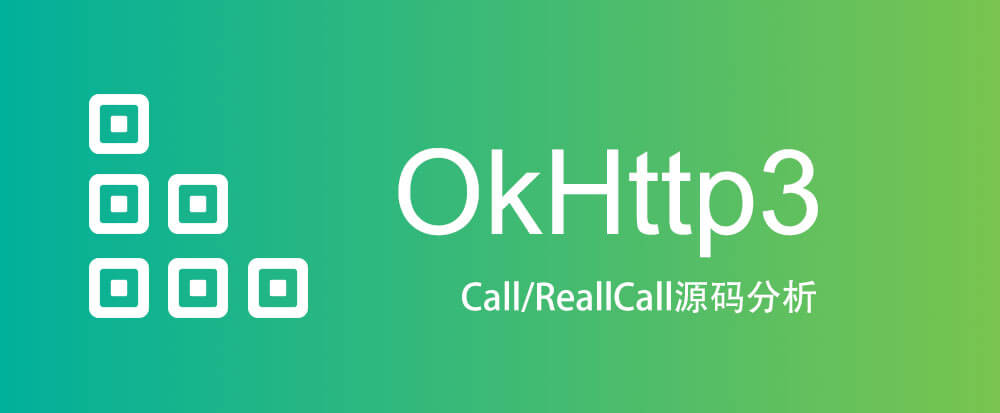OkHttp【三】Call/RealCall源码分析
2017-12-22 小文字
前言
在OkHttpClient实例化一个请求时,我们使用了newCall方法来构造一个Call对象,并执行。
本文一起分析Call的相关实现逻辑。
/**
* Prepares the {@code request} to be executed at some point in the future.
*/
@Override public Call newCall(Request request) {
return RealCall.newRealCall(this, request, false /* for web socket */);
}
Call 的作用
Call是一个接口,具体实现类为RealCall, 可以从接口定义了解其作用和定位。
public interface Call extends Cloneable {
Request request();
Response execute() throws IOException;
void enqueue(Callback responseCallback);
void cancel();
boolean isExecuted();
boolean isCanceled();
Call clone();
interface Factory {
Call newCall(Request request);
}
}
原代码注释很全,简单理解就是:Call是准备好可以执行的请求,允许被取消,但是一个Call只能执行一次。
主要的几个方法如下:
- request()
由于请求参数配置是通过
Request来封装,因此Call会持有Request对象实例,并提供get方法。 - execute()
同步执行请求,并返回
Response - enqueue() 异步执行请求,并将结果通过回调接口返回
- cancel() 取消请求,不一定可靠,已经开始的请求时中断不了的
RealCall 的实现
RealCall毋庸置疑,实现了Call接口,并且会持有一些成员:
- OkHttpClient 用于分发请求
- RetryAndFollowUpInterceptor 用于重试
- EventListener
消息监听器,这个比较恶心,和Call相互依赖,具体代码在
newRealCall的实现
static RealCall newRealCall(OkHttpClient client, Request originalRequest, boolean forWebSocket) {
// Safely publish the Call instance to the EventListener.
RealCall call = new RealCall(client, originalRequest, forWebSocket);
call.eventListener = client.eventListenerFactory().create(call);
return call;
}
同步execute
整个RealCall的实现主要在于同步执行和异步执行两个方法,先看下同步execute:
@Override public Response execute() throws IOException {
synchronized (this) {
if (executed) throw new IllegalStateException("Already Executed");
executed = true;
}
captureCallStackTrace();
eventListener.callStart(this);
try {
client.dispatcher().executed(this);
Response result = getResponseWithInterceptorChain();
if (result == null) throw new IOException("Canceled");
return result;
} catch (IOException e) {
eventListener.callFailed(this, e);
throw e;
} finally {
client.dispatcher().finished(this);
}
}
可以看到,同步执行请求时,会做一下判断,重复执行直接抛异常。整个过程通过eventListener来通知状态,比如callStart,callFailed,finished。
Response的返回放在了getResponseWithInterceptorChain方法中,我们知道OkHttp允许我们配置各种拦截器,就是利用了这个链式拦截器来实现的。
即使我们没有主动配置任何拦截器,也会有至少有内置的5个拦截器。针对这几个拦截器的实现,后续我们在单独分析。
现在我们已经知道要返回一个Response需要经过很多链式调用,负责链式调用的类就是RealInterceptorChain,这个类内部会为每个拦截器递归实例化一个RealInterceptorChain,并执行响应的方法。
Response getResponseWithInterceptorChain() throws IOException {
// Build a full stack of interceptors.
List<Interceptor> interceptors = new ArrayList<>();
interceptors.addAll(client.interceptors());
interceptors.add(retryAndFollowUpInterceptor);
interceptors.add(new BridgeInterceptor(client.cookieJar()));
interceptors.add(new CacheInterceptor(client.internalCache()));
interceptors.add(new ConnectInterceptor(client));
if (!forWebSocket) {
interceptors.addAll(client.networkInterceptors());
}
interceptors.add(new CallServerInterceptor(forWebSocket));
Interceptor.Chain chain = new RealInterceptorChain(interceptors, null, null, null, 0,
originalRequest, this, eventListener, client.connectTimeoutMillis(),
client.readTimeoutMillis(), client.writeTimeoutMillis());
return chain.proceed(originalRequest);
}
注意一个RealInterceptorChain的proceed是会被调用者执行的,第一次调用是在RealCall中,后续则是每次被拦截器的具体实现类调用Interceptor#intercept.
最后一个拦截器是CallServerInterceptor,看名字就可以猜到他是真正执行网络请求的类,前面的一些都只是加工,比如缓存处理,连接池等等。
链式调用拦截器
在遍历每个拦截器时都会专门创建一个RealInterceptorChain,因此我们来看下这个Chain都会做些什么事情?
通过阅读proceed方法可以看到它主要是在遍历拦截器,为每个拦截器实例化一个独立的Chain对象,同时根据遍历情况,做了大量的异常抛出,这样可以使非预期的执行被暴露出来。
public Response proceed(Request request, StreamAllocation streamAllocation, HttpCodec httpCodec,
RealConnection connection) throws IOException {
if (index >= interceptors.size()) throw new AssertionError();
calls++;
// If we already have a stream, confirm that the incoming request will use it.
if (this.httpCodec != null && !this.connection.supportsUrl(request.url())) {
throw new IllegalStateException("network interceptor " + interceptors.get(index - 1)
+ " must retain the same host and port");
}
// If we already have a stream, confirm that this is the only call to chain.proceed().
if (this.httpCodec != null && calls > 1) {
throw new IllegalStateException("network interceptor " + interceptors.get(index - 1)
+ " must call proceed() exactly once");
}
// Call the next interceptor in the chain.
RealInterceptorChain next = new RealInterceptorChain(interceptors, streamAllocation, httpCodec,
connection, index + 1, request, call, eventListener, connectTimeout, readTimeout,
writeTimeout);
Interceptor interceptor = interceptors.get(index);
Response response = interceptor.intercept(next);
// Confirm that the next interceptor made its required call to chain.proceed().
if (httpCodec != null && index + 1 < interceptors.size() && next.calls != 1) {
throw new IllegalStateException("network interceptor " + interceptor
+ " must call proceed() exactly once");
}
// Confirm that the intercepted response isn't null.
if (response == null) {
throw new NullPointerException("interceptor " + interceptor + " returned null");
}
if (response.body() == null) {
throw new IllegalStateException(
"interceptor " + interceptor + " returned a response with no body");
}
return response;
}
上述实现中最核心的就是递归实例化,形成了链式依赖,每一个拦截器的返回都会需要下一个拦截器的的返回结果。 在这里每个Chain都是通过proceed返回Response,在proceed中调用下一个拦截器的intercept方法,而intercept的实现中又必然会调用Chain的proceed方法,直到最后一个链。
RealInterceptorChain#proceed
// Call the next interceptor in the chain.
RealInterceptorChain next = new RealInterceptorChain(interceptors, streamAllocation, httpCodec,
connection, index + 1, request, call, eventListener, connectTimeout, readTimeout,
writeTimeout);
Interceptor interceptor = interceptors.get(index);
Response response = interceptor.intercept(next);
RetryAndFollowUpInterceptor#intercept
@Override public Response intercept(Chain chain) throws IOException {
Request request = chain.request();
RealInterceptorChain realChain = (RealInterceptorChain) chain;
Call call = realChain.call();
// ...
while (true) {
if (canceled) {
streamAllocation.release();
throw new IOException("Canceled");
}
Response response;
boolean releaseConnection = true;
try {
response = realChain.proceed(request, streamAllocation, null, null);
releaseConnection = false;
} catch (RouteException e) {
// The attempt to connect via a route failed. The request will not have been sent.
if (!recover(e.getLastConnectException(), false, request)) {
throw e.getLastConnectException();
}
releaseConnection = false;
continue;
}
// ...
}
// ...
}
}
异步enqueue
现在简单分析下异步调用,可以看到他们的主要差异在于,执行call会被丢到一个队列中,由OkHttpClient的分发器进行调用。
@Override public void enqueue(Callback responseCallback) {
synchronized (this) {
if (executed) throw new IllegalStateException("Already Executed");
executed = true;
}
captureCallStackTrace();
eventListener.callStart(this);
client.dispatcher().enqueue(new AsyncCall(responseCallback));
}
可以推测AsynCall内部会有和同步执行类似调用关系, 这里的AsynCall实际上就是一个Runnable,只是做了一下命名和简单包装execute方法
final class AsyncCall extends NamedRunnable {
private final Callback responseCallback;
AsyncCall(Callback responseCallback) {
super("OkHttp %s", redactedUrl());
this.responseCallback = responseCallback;
}
// ...
@Override protected void execute() {
boolean signalledCallback = false;
try {
Response response = getResponseWithInterceptorChain();
if (retryAndFollowUpInterceptor.isCanceled()) {
signalledCallback = true;
responseCallback.onFailure(RealCall.this, new IOException("Canceled"));
} else {
signalledCallback = true;
responseCallback.onResponse(RealCall.this, response);
}
} catch (IOException e) {
if (signalledCallback) {
// Do not signal the callback twice!
Platform.get().log(INFO, "Callback failure for " + toLoggableString(), e);
} else {
eventListener.callFailed(RealCall.this, e);
responseCallback.onFailure(RealCall.this, e);
}
} finally {
client.dispatcher().finished(this);
}
}
}
在execute中,还是通过前面分析的getResponseWithInterceptorChain来返回Response,除此之外就是eventListener的消息回调,已经最后的响应回调。
可以看到这里的响应回调就是直接在当前线程执行了Callback的方法,因此不存在线程调度问题,因为OkHttp是可以给纯Java项目使用的,对线程的调度应该在其他地方。
关于这一点后续我们可以做实验来验证一下。